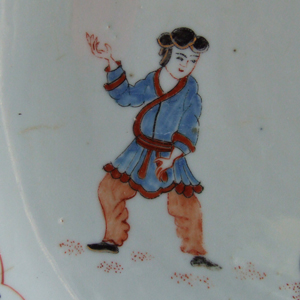
KANGXI or YONGZHENG c.1700-1730 Dutch Decorated Chinese Export Porcelain
An Early 18th Century Chinese Export Porcelain Saucer Shaped Dish, Late Kangxi or Yongzheng c.1700-1730. Decorated in Holland with the Kakiemon Style `Hob-in-the-Well` Pattern c.1720-1730. The Rim Bound in Bronze, French ?, 18th Century.
SOLD
- Condition
- Two cracks to the rim.
- Size
- Diameter : 27.5 cm (10 3/4 inches)
- Provenance
- ICF. Vincent l`Herron, Paris. 15th June 2001. The Helen Espir Collection of European Decorated Chinese Export Porcelain : "a member of the Oriental Ceramic Society and collector, with her husband. Having made a typical collection of Song and provincial Ming blue and white, they decided to concentrate on what used to be called `clobbered` porcelain. She is the author of the standard work on the subject, European Decoration on Oriental Porcelain,2005, the first to examine the work of European decorators on Chinese porcelain throughout the eighteenth and nineteenth centuries, focusing on enamellers in Holland, Germany and England. She has learned Chinese." From Provenance ; Collectors, Dealers & Scholars : Chinese Ceramics in Britain & America (Roy Davids, Dominic Jellinek, Privately Printed, 2011. ISBN 978-0-9570148-0-0).
- Stock number
- 23667
- References
- European Decoration on Oriental Porcelain 1700 - 1830 (Helen Espir, Jorge Welsh Books, 2005) page 82, plate 13.
Information
This Chinese porcelain dish was plain white when it arrived in Europe making it a perfect candidate for the Kakiemon design. A service decorated with the `Hob-in-the-Well` pattern turned up in a provincial auction in Holland some 15 years ago. It was made up using white porcelain from China, Japan as well as Viennese porcelain from Du Paquier as well as early Meissen. As far as I can recall that service was painted by a different hand, the painting was not as sophisticated as the present example.
The `Hob-in-the-Well` Pattern :
This well known and popular pattern derives from late 17th century Japanese Kakiemon porcelain, indeed it is possibly the best known of all Kakiemon designs. However European versions are more commonly encountered. There are Dutch decorated versions of this pattern as well as at least two Meissen versions, some of which were in The Japanisches Palais (Japanese Palace) belonging to Augustus the Strong (Augustus II 1670-1733 King of Poland and Elector of Saxony). Other examples are found on English porcelain for example from the Chelsea factory c.1755. The rather charming design was popular in Japan in the late 17th century where the central character was known as Shiba Onko but the origin of the story goes right back to Song Dynasty China. It tells the story of the statesman Sima Guang who, as a child is reputed to have been very quick witted. When a friend was drowning in a large pottery jar he picked up rocks throw them at the jar until it broke thus saving his friends life. Helen Espir`s notes about this dish suggest the name `Hob-in-the-Well` derives from a popular play in England hence the connection with Chelsea porcelain.
Kakiemon Porcelain :
Kakiemon decoration is usually of high quality, often delicate and with well-balanced asymmetric designs. The designs were normally quite sparse emphasizing the fine white porcelain body known in Japan as Nigoshide (milky white). The opaque white milky Nigoshide body was used on the finest pieces, it appears that it was reserved for fine quality enamelled decoration. Kakiemon porcelain was decorated with a great variety of imaginative designs which include elements such as the `banded hedge`, `flying squirrel`, and the `Quail and Millet` design. The `Three Friends of Winter` were also a very popular group of designs, other subject taken from nature include flowers (especially the chrysanthemum, the national flower of Japan) as well as birds and rock-work. Figural subjects such as the `Hob in the Well` were also popular. This design illustrates a Chinese folk tale where a sage saves his friend who has fallen into a large fish-bowl by throwing stones at it, braking open the pot. Banded-Hedges were a formal device within Japanese traditional gardens, they were often incorporated in designs, includes `The Three Friends of Winter` (Pine, Bamboo and Prunus). These three plants signify perseverance, as neither the pine nor the bamboo shed their leaves in winter and the plumb (Prunus) flowers at the very end of the winter, heralding the arrival of spring.